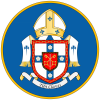A Sword Shall Pierce
The Seven Sorrows (or Dolors) of our Blessed Lady are:
- The Prophecy of Simeon
- The Flight into Egypt
- The Loss of the Child Jesus in the Temple of Jerusalem
- Mary meeting Jesus on the Via Dolorosa
- The Crucifixion of Jesus on Mount Calvary
- Jesus’s Descent from the Cross
- The Burial of Jesus by Joseph of Arimathea
In 1232, seven youths in Tuscany founded the Servite Order. Five years later, they took up the sorrows of Mary, standing under the Cross, as the principal devotion of their order. Over the centuries several devotions, and even orders, arose around meditation on Mary’s Sorrows in particular. The Servites developed the three most common devotions to Our Lady’s Sorrows, namely the Rosary of the Seven Sorrows, the Black Scapular of the Seven Dolours of Mary and the Novena to Our S
The Rosary consists of a chaplet of seven septets of beads (upon which is said an Ave), separated by one bead (on which is prayed a Pater Noster. Meditations for each dolor were composed by Pope Pius VII in 1818. The Black Scapular is a symbol of the Confraternity of Our Lady of Sorrows, which is associated with the Servite Order. Most devotional scapulars have requirements regarding ornamentation or design. The devotion of the Black Scapular requires only that it be made of black woolen cloth. From the National Shrine of Saint Peregrine spread the Sorrowful Mother Novena, the core of which is the Via Matris.
The Feast of Our Lady of Sorrows grew in popularity in the 12th century, and in a provincial synod of Cologne in 1423 was designated for the Friday after the third Sunday after Easter. Before the sixteenth century this feast was limited to the dioceses of North Germany, Scandinavia, and Scotland. After 1600 it became popular in France and was set for the Friday before Palm Sunday. By a Decree of 22 April 1727, Pope Benedict XIII extended this observation to the entire Latin Church, under the title “Septem dolorum B.M.V.” Meanwhile, in 1668, a separate feast of the Seven Sorrows of Mary, celebrated on the third Sunday in September, was granted to the Servites. Pope Innocent XII renamed it the Feast of Our Lady of Sorrows and Pope Pius VII introduced it into the General Roman Calendar in 1814. In 1913, Pope Pius X, in view of his reform giving precedence to Sundays over ordinary feasts, moved this feast to September 15, the day after the Feast of the Exaltation of Holy Cross.
The two feasts of the Seven Sorrows are celebrated today only by Catholics faithful to the traditional calendar, giving us the opportunity to offer reparation to our Blessed Mother twice a year, and extending our devotions throughout the entire month of September.
